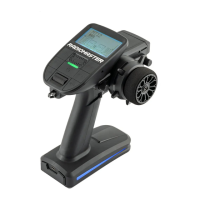
Do you have a question about the RadioMaster MT12 and is the answer not in the manual?
| Channels | 16 |
|---|---|
| Gimbals | Hall Sensor |
| Frequency | 2.4GHz |
| Antenna | Internal |
| Operating System | EdgeTX |
| Simulator Support | Yes |
| USB-C Charging | Yes |
| SD Card | Yes |
| Telemetry | Yes |
| Switches | 6 |
| Knobs | 2 |
| Sliders | 2 |
| Compatibility | Multiple protocols |
| RF Power | 100mW |
| Operating Current | 200mA |
| Voltage Range | 6.5V - 8.4V |
| Control Distance | Up to 2km |
| Firmware Upgrade Method | USB |
| Internal RF | Yes |
| External Module Support | Yes |
| Dimensions | 180 x 170 x 100 mm |
| Battery | 2S LiPo |
| RF Protocol | Multiple protocols |
Introduces the RadioMaster MT12, its features, and advises reading the manual.
Details crucial safety precautions for operating the MT12 radio system and models.
Provides a visual breakdown of the MT12's physical components and their labels.
Explains the MT12's battery requirements, charging methods, and safety guidelines.
Guides users on how to download the latest manual and firmware for the MT12.
Lists the technical specifications and dimensions of the MT12 radio system.
Outlines the warranty period and procedures for handling hardware issues.
Covers legal disclaimers, copyright information, and licensing for the EdgeTX firmware.
Provides links to video tutorials for binding receivers with the MT12.
Details the function and operation of each physical button on the MT12 radio.
Explains the different screen displays and information presented on the MT12's main view.
Describes how to reset various settings and timers on the MT12 radio.
Presents information on radio usage statistics and debug screens.
Guides on setting up custom colors and effects for the MT12's RGB LEDs using LUA scripts.
Details the installation and software setup for expansion modules.
Explains how to select, create, copy, move, and delete models on the MT12.
Guides on configuring fundamental model-specific settings like name and timers.
Allows configuring different trim settings for each Drive mode, with up to nine possible modes.
Explains how to configure failsafe settings for 4in1 Multi-Protocol and ExpressLRS receivers.
Details how to change the direction of a servo's movement through the OUTPUTS screen.
Guides on setting exponential curves for channels to adjust stick sensitivity.
Explains how to set up dual rates for a switch, allowing different rates for different positions.
Describes how to adjust the minimum and maximum endpoints for a channel's output.
Explains mapping physical controls to software inputs and applying modifiers like weight and offset.
Details parameters for configuring inputs, including name, source, weight, offset, and curve.
Guides on combining inputs into channel mixes, assigning weights, offsets, and curves.
Covers final adjustments to control data, including subtrim, endpoints, and direction.
Allows defining custom curves for use in Inputs, Mixes, or Outputs, with graphical representation.
Explains configuring virtual switches based on logical expressions for use anywhere physical switches are defined.
Guides on adding functionality beyond model controls, like enabling trainer mode or playing sounds.
Details how to discover, add, edit, and delete telemetry sensors for data display.
Configures thresholds for RX alarms like low, critical, and disable alarms.
Configures variometer alarms for detecting altitude changes, including source, range, and tone settings.
Configures up to four telemetry screens using numbers, bars, or script display types.
Allows selection and execution of Lua script-based tools for radio functions.
Guides on configuring basic radio settings like date, time, sound, volume, and backlight.
Explains how special functions can apply to all models and are configured similarly to model functions.
Details how to configure the radio in Master mode to handle signals from a Slave mode radio.
Covers hardware-specific settings, calibration of sticks/pots, and additional configuration options.
Displays information about the current EdgeTX version, build options, and module/RX versions.
Acknowledges individuals and groups who contributed to the manual and EdgeTX.
Provides links to the EdgeTX website, update tools, and support information.
